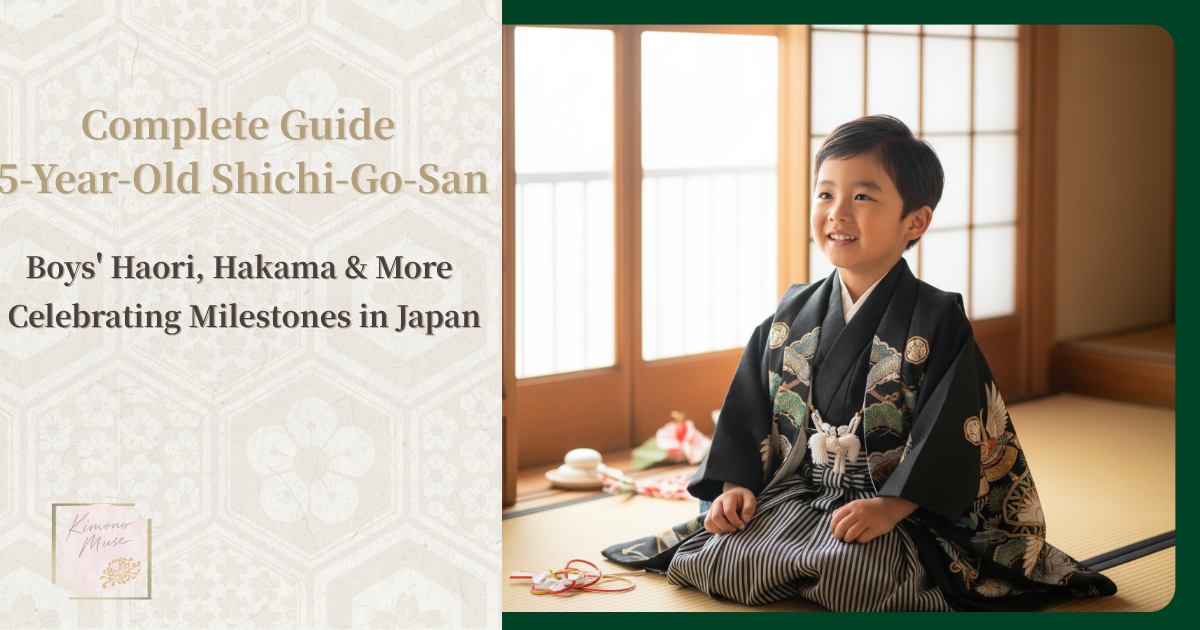The Shichi-Go-San celebration at age five is a particularly important milestone for boys.
Dressed in a traditional haori and hakama, their dignified appearance becomes a moment for families to truly feel their child’s growth.
In this article, we explain the origins and meaning of the 5-year-old Shichi-Go-San, how to choose the right haori and hakama, tips for photo sessions, and the flow of the shrine visit.
We’ve gathered helpful insights to ensure this special occasion becomes a cherished family memory.
What Is the 5-Year-Old Shichi-Go-San?
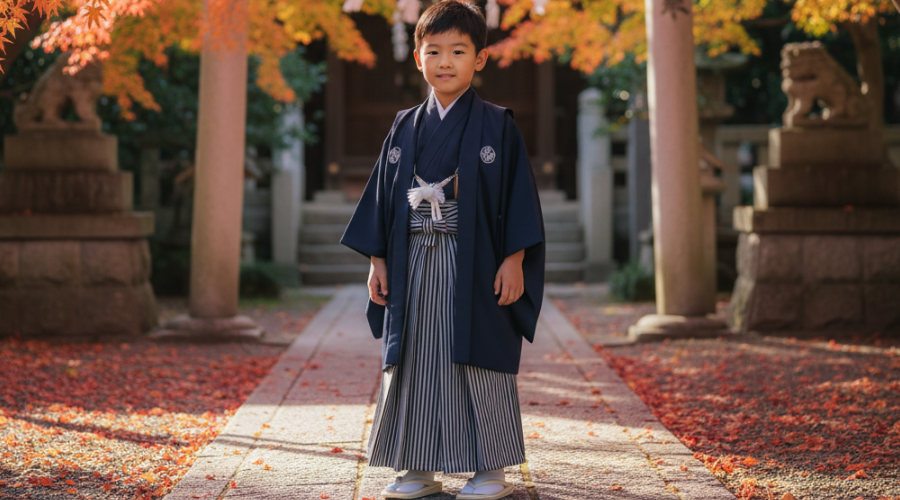
Shichi-Go-San is a traditional Japanese celebration that prays for the healthy growth of children.
The 5-year-old Shichi-Go-San, in particular, originates from the ceremony called Hakamagi no Gi (袴着の儀).
This ritual marked the moment when boys began wearing hakama—traditional pleated trousers—instead of children’s kimono, symbolizing their first step into adulthood.
Before the Edo period, both boys and girls took part in this rite, but during the Edo era it became a custom exclusively for samurai boys. Today, it remains a celebration for boys at the age of five.
For parents, it can be both surprising and deeply moving to see a son, who until recently seemed so little, now wearing the dignified attire of haori and hakama.
In that slightly grown-up appearance, families may feel a mix of joy in watching their child’s growth and a touch of bittersweetness—a unique emotion that makes Shichi-Go-San such a special milestone.
Preparation – Key Points for a Smooth Shichi-Go-San Celebration
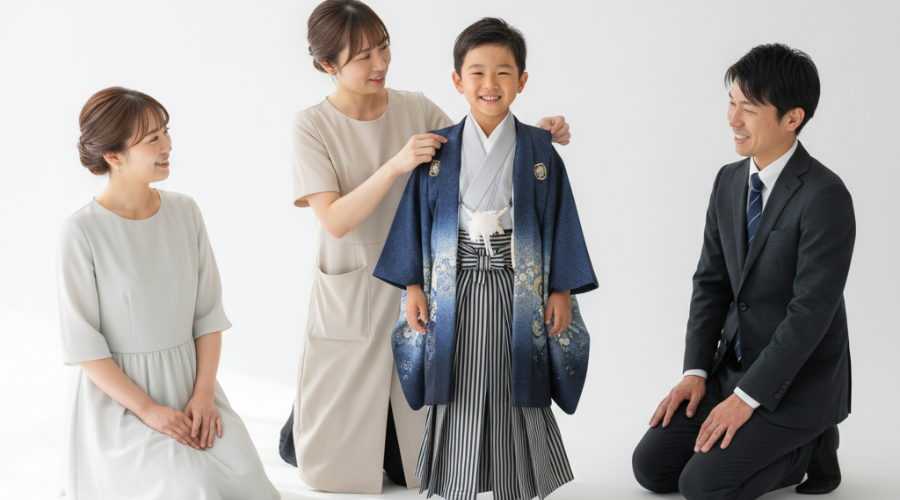
The 5-year-old Shichi-Go-San is a special milestone where children themselves begin to understand the meaning of the event.
It’s important to keep your child’s feelings at the center, making thoughtful preparations so the day can be filled with smiles.
From choosing the outfit to the shrine visit and commemorative photos, taking the time to prepare each step with care becomes a meaningful way to celebrate your child’s healthy growth.
Outfit Preparation – Kimono or Western-Style Clothing?
For 5-year-old boys, the dignified look of a haori and hakama is especially striking.
Many families may wonder whether to choose the traditional kimono style or opt for the easier-to-move-in Western-style outfit.
By understanding the features of each, you can make the best choice for your child and family.
▶ Kimono: Formal Elegance with Haori and Hakama
When it comes to the 5-year-old Shichi-Go-San, haori and hakama are the classic choice.
The crisp, dignified appearance allows families to truly feel their child’s growth.
・Choosing Colors and Patterns
Traditional solid colors like black or navy create a formal look and stand out beautifully against any background.
Designs featuring auspicious motifs such as hawks, dragons, or samurai helmets (kabuto) express a strong and boyish charm.
When taking family photos, it’s best to consider harmony with the outfits of parents and siblings to achieve a well-balanced look.
・Fabric and Comfort
The texture and price vary depending on the material, such as pure silk or synthetic fabrics.
To ensure your child stays comfortable even while wearing the outfit for long hours, it’s important to adjust the fit properly and pay attention to the tightness of the obi belt during dressing.
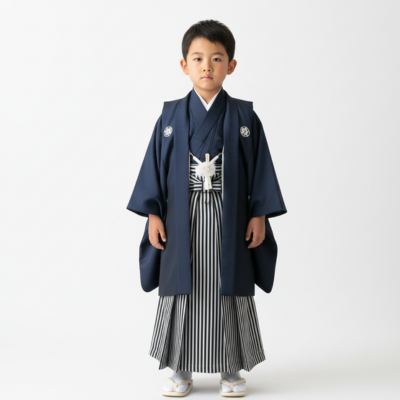
▶ Western-Style: Comfortable in a Suit or Jacket
While traditional kimono is beautiful, Western-style outfits are also recommended for active children as they allow greater ease of movement.
・Suit or Jacket Style
A formal outfit, different from everyday wear, helps create the special atmosphere of Shichi-Go-San.
By choosing colors and designs your child likes, they will feel more excited and it will be easier to capture natural, happy smiles in photos.
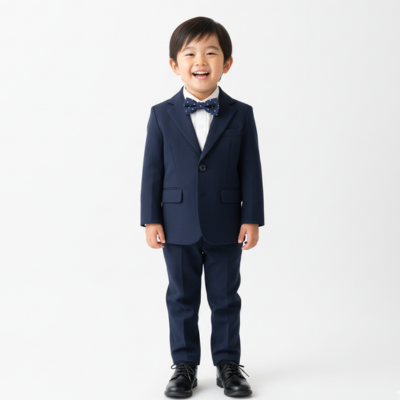
The most important point for a wonderful Shichi-Go-San is to remember that your child is the star of the day.
Choosing an outfit that matches what they want to wear, what they like, and how they feel on the day ensures a comfortable and enjoyable celebration.
Shrine Visit – Flow and Key Points to Remember
Now it’s time to head to the shrine. By understanding the flow in advance, you can avoid feeling rushed on the day and instead share a calm, sacred moment with your child.
1. Before Departure: Check Clothing and Belongings
Clothing:
- Main Outfit: Since haori and hakama can be difficult to move in if unfamiliar, have your child try them on at home beforehand and practice walking. Traditional sandals can slip off easily, so check that socks and footwear are the right size, and teach your child tips for walking, such as sliding their feet.
- Accompanying Family Members’ Outfits: Parents and relatives should also choose clothing that is formal enough while still appropriate for the occasion. Both traditional and Western-style outfits are fine, but selecting colors and styles that harmonize with the child’s attire will create a unified look in photos.
Belongings:
- Bag for Candy: After the prayer, children often receive long-life candy and protective charms, so it’s convenient to have a carry bag (about A4 size).
- Snacks and Drinks: Waiting times may be long due to crowds. Bring small snacks and drinks that your child can eat easily to keep them from getting restless.
- Diapers and Change of Clothes: If your child is still small, be sure to bring these items.
- Camera or Video Camera: Don’t forget this for commemorative photos. A mobile battery or spare SD card will also give you peace of mind.
- Offering (monetary donation): Prepare the offering in advance by placing it in an envelope and writing “offering” along with your name. Using a decorative envelope is the standard practice. The usual amount is about 5,000 to 10,000 yen, but it may vary depending on the shrine, so be sure to check in advance.
2. Arrival at the Shrine – Reception
Purification Fountain (Temizuya): After passing through the torii gate, begin by purifying yourself at the water pavilion.
- Hold the ladle in your right hand, scoop water, and pour it over your left hand.
- Switch the ladle to your left hand and wash your right hand.
- Switch the ladle back to your right hand, pour water into your left hand, and rinse your mouth.
- Rinse your left hand again, then tip the ladle upright so the remaining water runs down the handle to cleanse it, and return it to its place.
Reception: At the shrine office or designated reception desk, apply for the prayer service. If you have a reservation, give your reservation name. For same-day applications, fill in the required information on the application form.
Offering (monetary donation): Present your offering at the reception desk. Place it in a decorative envelope before handing it over.
3. Prayer Ceremony
Waiting: After completing reception, wait in the designated waiting room or area until it is your turn. Depending on the shrine’s customs, you may share the ceremony with other families.
Proceeding to the Main Hall: When your turn comes, follow the guidance of the staff and move into the main hall.
Prayer Ceremony:
- A Shinto priest will recite prayers (norito) to wish for your child’s healthy growth.
- In some cases, a ritual called tamagushi hōten (offering a sacred sakaki branch) will also be performed. You will receive the branch and place it at the altar. The priest will explain how to do this, so there’s no need to worry.
- To help prevent your child from getting restless during the ceremony, it can be reassuring to explain in advance, “We’re going to greet the gods together.”
4. Worship and Commemorative Photos
After the Prayer Ceremony: Once the prayer is finished, your child will receive long-life candy, protective charms, or commemorative items.
Individual Worship: After the formal prayer in the main hall, you may also worship individually. The standard practice is called “two bows, two claps, one bow.”
- Step forward to the altar and bow lightly.
- Bow deeply twice.
- Bring your hands together at chest height and clap twice.
- Keep your hands together, offer your gratitude and prayer silently.
- Finish with one more deep bow.
Commemorative Photos:
- Depending on the shrine, certain spots (such as in front of the torii gate, the purification fountain, or the main hall) are especially popular for photos.
- If hiring a professional photographer, check in advance whether a photography permit is required.
- To capture your child’s best smile, it can help to use their favorite toy or have grandparents join in to encourage them.
If you wish to have a prayer ceremony, it is recommended to make a reservation in advance.
Some shrines accept same-day applications, but checking ahead of time will ensure smoother arrangements and peace of mind.
Notes and Tips
- Outfit Comfort: Haori and hakama are highly formal attire, but they can become tiring to wear for long periods, and traditional sandals may be difficult to walk in. Practicing walking at home beforehand will help your child feel more comfortable.
- Crowd Management: At popular shrines, waiting times can be long. If you have younger siblings with you, bring snacks and drinks to keep them comfortable.
- Commemorative Items: After the prayer ceremony, children often receive long-life candy or protective charms. Having a bag ready to carry these items home is convenient.
- Advance Reservations: For prayer ceremonies, especially at popular shrines, reservations may be required. Weekends and auspicious days such as taian are very busy, so booking early is reassuring.
- Health and Well-being: Unfamiliar clothing and long outings can tire children easily. Make sure they get enough rest the night before so they can enjoy the day in good condition.
- Shrine Rules: Some shrines have specific rules regarding photography spots or behavior during the prayer ceremony (such as turning off mobile phones). Check the official website in advance to avoid surprises.
At age three, one of the biggest challenges was whether the child could sit still, but by age five they are often able to calmly take part in the prayer ceremony. For parents, this brings even more moments of pride as they witness their child’s growth.
Events of the Day: Photography and Family Meal
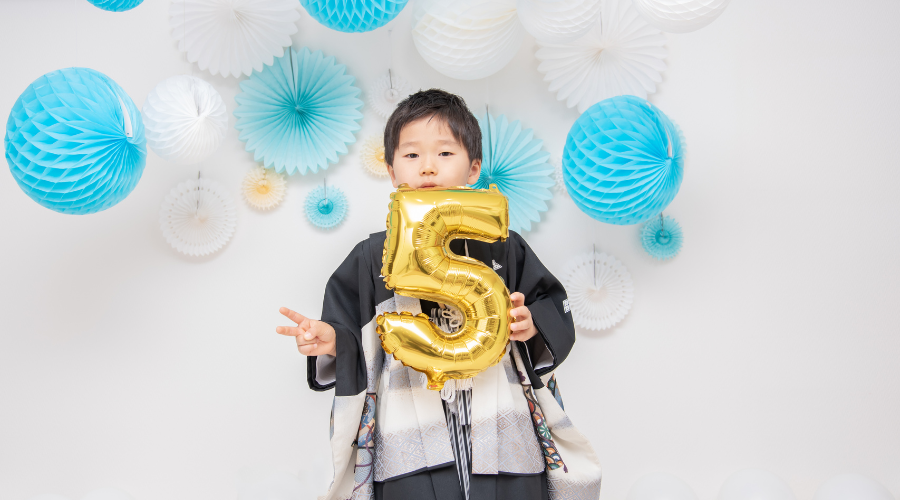
The 5-year-old Shichi-Go-San is a precious opportunity to capture your child’s growth in photographs.
Unlike at age three, by age five boys begin to show a more dignified presence and expressions that reveal they are growing into “big brothers.”
To create the best commemorative photos, here are some key points to keep in mind.
Tips for Commemorative Photos
By the age of five, children can understand poses and instructions, making photo sessions more versatile.
Encouraging playful posing or letting them hold a favorite item can help bring out natural smiles.
And don’t forget to capture photos with the whole family together as well.
▶ Bringing Out Natural Expressions
・Incorporate Play
Many children feel nervous when a camera is pointed at them. Let them play with a favorite toy during the session, or make them giggle to bring out genuine smiles. Asking, “Show me your coolest pose!” can also be a fun way to spark natural expressions.
・Change Locations
In addition to the shrine grounds, try taking photos along the approach path or in the garden. A change of scenery can refresh your child’s mood and reveal new sides of their expression.
・Parents Join the Fun
When children see their parents enjoying themselves, they feel more relaxed during the shoot. Laugh together, talk to them, and keep the overall atmosphere cheerful.
▶ Timing for Photos
・Morning sessions are recommended: Children tend to have more energy and focus earlier in the day, making the morning an ideal time to start the photo shoot.
・Include meals and breaks: If the session lasts a long time, taking short breaks with favorite snacks or drinks will help keep your child in a good mood.
・Separate the prayer and photo shoot into different days: To reduce the burden on your child, it’s also a good idea to hold the shrine prayer and studio photo session on separate days.
Since haori and hakama can be difficult to move around in, it’s reassuring if your child is already accustomed to wearing traditional sandals and socks during travel and waiting times.
Celebratory Family Meal
Shichi-Go-San is also a celebration of family milestones and a precious opportunity for grandparents to witness their grandchild’s growth.
By the age of five, children have become more mature, and many families wish to show their grandparents the child’s special appearance.
Enjoying a family meal together after the shrine visit and photo session also becomes a wonderful memory to cherish.
For details on how to coordinate with grandparents, please refer to [this article].
Q&A – Solving Common Concerns About the 5-Year-Old Shichi-Go-San

Here we’ve answered common questions and concerns about the 5-year-old Shichi-Go-San.
Use these as helpful hints when preparing for the celebration.
**Q1. Is it necessary for boys to wear haori and hakama?**
A: Traditionally, haori and hakama are the standard attire, but it is not absolutely required. More families are now choosing easier-to-move-in kimono styles or even Western-style outfits.
**Q2. What if my child can’t stay focused during the photo session?**
A: It’s best to divide the session into shorter segments. Using a favorite toy or making poses feel like a game helps bring out natural smiles.
**Q3. Should grandparents join us for the shrine visit?**
A: It depends on your family’s style. Inviting grandparents makes the celebration more festive, but having more people can also increase the burden of travel and schedule coordination. The important thing is to choose an arrangement that feels comfortable for your family.
Summary
The 5-year-old Shichi-Go-San is a special milestone that celebrates a boy’s growth in traditional haori and hakama.
There may be many things to prepare—choosing the outfit, planning the photo session, arranging the shrine visit—but taking each step one at a time will help the day unfold smoothly.
What matters most is not perfection, but sharing in the joy of your child’s unique presence together as a family.
May this year’s Shichi-Go-San become a memorable day that reflects the spirit of your family.
Related Articles
▶ Complete Guide to Shichi-Go-San at Age 3
▶ Complete Guide to Shichi-Go-San at Age 7
✿ Column: Fumi’s Kimono Diary ✿
When people think of the 5-year-old Shichi-Go-San, the image of boys dressed in haori and hakama often comes to mind.
Seeing a child who just last year still seemed so young now standing tall with dignity moves many families with the speed of their growth.
Flipping through old albums, you may even find photos of parents or grandparents at their own Shichi-Go-San. It is a moment that makes you realize how this tradition has been passed down across generations.
Shichi-Go-San reminds us that it is not only the formal appearance on the day itself, but also the preparations leading up to it and the memories afterward, that become treasured parts of a family’s story.
